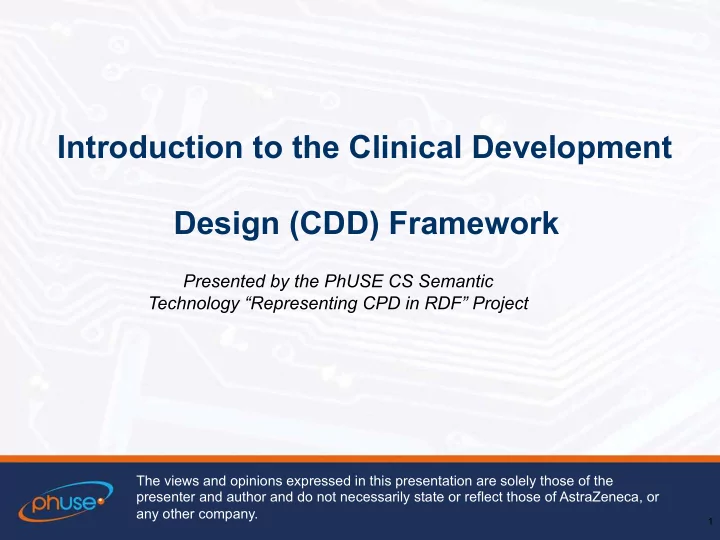

Introduction to the Clinical Development Design (CDD) Framework Presented by the PhUSE CS Semantic Technology “Representing CPD in RDF” Project The views and opinions expressed in this presentation are solely those of the presenter and author and do not necessarily state or reflect those of AstraZeneca, or any other company. 1
Presentation Outline • CDD Team • History of the Program • Original Plan: Structured Information Model • Stepped Back: Completed the PhUSE Deliverable Template • Overview, Purpose, Scope • Definitions • Problem Statement • Recommendations • DREAMING 2
CDD Team Team Member (Affiliation) Team Member (Affiliation) Mary Banach ( Vanderbilt) Matt Austin (Amgen) Tarek Elbeik ( Elbeik Associates) Asiyah Yu Lin (FDA) Maria Benjegard ( AstraZeneca) Kerstin Forsberg (AstraZeneca) Hon Sum Ko ( FDA) Dale Plummer (Vanderbilt) Steven Hirschfeld (USUHS) Johan Proeve (CDM Consulting) Ian Fisher (Quintiles) Stephen Wilson (FDA) Mitra Rocca (FDA) Laszlo Vasko (AstraZeneca) Rashedul Hasan (FDA) 3
Smart Program Design Information Model Value Efficacy Safety Input into design Claim Claim Claim of next phase Objective 2 Objective 1 Objective 3 Program Level Design Elements Interpretation of Results Program Design Endpoint 3 Endpoint 1 Endpoint 2 Endpoint 3 Assess Assess Compar Patienopul Population Patient Assessment Design Location Treatment Comparator ments ments ators ation Population Study Study Trial Trial Prototype Prototype Prototype Prototype Program Program Option Option Trial/Protocol Level Trial Trial Design Elements Specification Specification Vasko L, Sundgren M, Bachmann P, et al. Smart Program Design Through a Common Information Model. Therapeutic Innovation & Regulatory Science: DIA/Sage; 2014. 4
Development Program Design Structured Information Model Agency Reference Guidance Publications A common information model for Sources clinical program designs: Value Efficacy Safety Claim Claim Claim § Enable re-use of internal & publically available information Objective 2 Objective 1 Objective 3 Harmonized Standards § Reference & link agency Endpoint 3 Endpoint 1 Endpoint 2 Endpoint 3 guidance to design decision Compa rators Location Populatio Treatment § Build best practice within Asses Patienop Comparator Assessment n Patient sment ulation Design Population s companies and across industry § Facilitate information sharing Study Prototyp Trial between all stakeholders Prototype e § Enable creative / collaborative tools focusing on improving the quality of clinical development SDTM PRM programs and trial designs CDASH 5
PhUSE Deliverable Template 6
Overview, Purpose, Scope Overview: The Clinical Development Design (CDD) Framework aims to provide structure and rigor to the design of clinical development programs and to improve design decision making. Purpose: Delivering a plan for capturing structured design thinking in clinical research. Scope: Providing structure and rigor to the design process in clinical research – beginning with the language, terms, and vocabulary of the CDD. 7
CDD Framework Definitions • Design and Decision Making Terms • CDD-Specific Terms • Sources for Data to Construct our Database • Information Modeling Tools • Semantic Technology Terms 8
Problem Statement The CDD Framework aims to provide a defined structure with: • Data and links between the data • Design decision assumptions: constraints and supportive data • Cross-industry information model and terminology 9
Recommendations Build a CDD Ontology – database of terms that can then be used for modeling. § Download the data from the sources mentioned above into our CDD REDCap database § Build links and determine redundancies § Determine an agreed upon definition for each of the terms. THEN: We can make Cmaps, use Neo4j, and build a semantic technology base for the CDD. 10
DREAMING NEXT STEPS With a vocabulary we can build Cmaps as Rashedul Hasan has done here for Regs2RDF: 11
DREAMING NEXT, NEXT STEPS • With a vocabulary we can use Neo4j for showing the relationships between work products as Maria Benjegard and Kerstin Forsberg have done here for the Design to Deliver Guide: 12
Please Join Us • Need reviewers for vocabulary. • Need help with definitions and terminology. • Need help with links and understanding redundancies. • Contact: mary.banach@vanderbilt.edu 13
Recommend
More recommend